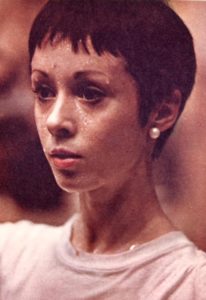Susan Marlys, retired Royal Ballet dancer, explains how her image obsession stayed with her even after retiring from performing.
I feel somewhat embarrassed by my neurosis. Is my obsession because I lived in the image conscious environment of the ballet world and should have shed the self absorption when I left?
Royal Ballet School

Susan Marlys centre of 2nd row from the back
I went to White Lodge (Royal Ballet junior school) when I was 12 years old. I auditioned in Canada while The Royal Ballet Company was performing in Vancouver. Because I was not accompanied by my parents, I was appointed a guardian in England who took care of me in the various holidays during the year.
Dancing years
I was 18 when I joined the company.

Susan Marlys Peasant Girl solo Act 1 Swan Lake
I retired from the company when I was 24. The Touring Company disbanded (in 1970) and I was one of the casualties of that decision. I had no regrets leaving as the final two years in the Company were very difficult. My husband was ill and committed suicide in May 1970, just before our final performances a month or so later. I was offered soloist positions with London’s Festival Ballet and the Canadian National Ballet but was burned out and emotionally fragile.
New careers
It is worth mentioning that there was no transition program available to retiring dancers at that time, so my search for employment (and for a new identity) was rather haphazard. I did a typing course, worked briefly as a secretary at Spinks & Sons, then was hired as a dancer in some of the historical series that were being filmed by the BBC and ITV. (War and Peace, The Strauss Family, Yeoman of the Guards, Katherine Mansfield).
I married again in 1972 to Yuval Zaliouk, former conductor of the RB Touring Company. We had 2 children and in 1980 moved to the United States where he became music director of the Toledo Symphony Orchestra. I taught dance, became an Artist in Residence with the Ohio Arts Council and was associated with The Lincoln Center Institute teaching dance in schools.
My weight concerns did not influence my choice of work. I worked in dance because it was the only skill that I had and I was offered the opportunities because of my background with the Royal Ballet (I had no teaching experience at all though!) However, I was still working in the dance field so my body image was very important to me.
A life of not performing

In ballet class in the Royal Ballet
It is worth noting that I was not taught any skills to adjust to life outside the protective environment of the Royal Ballet School and Company. I had a lot of problems with my identity. Because of my husband’s work in the international music world, I was introduced to famous soloists and conductors as a “former dancer with the Royal Ballet”. As long as I still looked like a dancer I could cope with the social pressures. It was important for me to keep my shape and image.
Now, years later, I still have that “appearance chip” imbedded in my brain despite circumstances having changed. I do not teach, I have more confidence and it no longer matters what my BMI is. We have a successful family business, we travel a great deal and my life is very happy and settled.

Susan, thank you for posting this. I can certainly identify with what you call your ‘appearance chip’ … that will be part of me for ever more. But it also made me sad to read about your lack of confidence or trust in the ‘non dancer you’ … as if dancing was the only thing you could do, so it is good to hear you are now comfortable in your non dancing life … chip ‘n all!
Thank you for your comment Dida